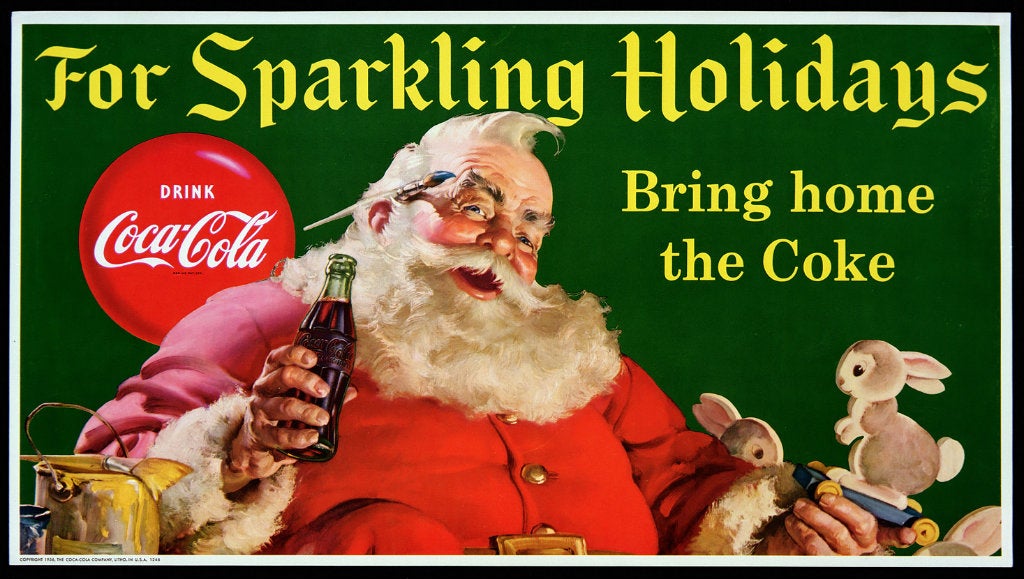The holidays are a great time for marketing thanks to one of the greatest business icons in history: Santa Claus . No matter what they call it, Santa Claus, Father Christmas, Saint Nicholas, etc., it is a legendary character who talks about Christmas, gifts, family reunions and in a very little known way, Coca-Cola .
 Haddon “Sunny” Sundblom / The Coca-Cola Company
Haddon “Sunny” Sundblom / The Coca-Cola Company
The Puro Marketing site points out that the origin of the person who brings gifts to the “good children” during Christmas Eve in the West has also made the most famous soft drink brand in the world a mandatory reference on these dates. Inspired by the real figure of a Christian bishop named Nicolás, today’s Santa Claus is more of a The Coca Cola Company ‘s manufacture, so much so that his traditional clothing, which for centuries was green, was transformed to match the brand’s motifs. .
This happened in 1931 when Coca-Cola launched a Christmas advertising campaign that focused on a Santa Claus wearing the corporate colors white and red.
One of the first illustrations of Santa Claus that comes close to our current interpretation of the character came in 1862 when American Civil War cartoonist Thomas Nast drew a little elf supporting Union soldiers at Christmas. This image would serve as the basis for the subsequent Coca-Cola campaign.

According to the firm’s Coke Lore site, the company began using the character in the 1920s in advertising for magazines such as The Saturday Evening Post, Ladies Home Journal , National Geographic , The New Yorker , among others, and they used an image a lot. most severe of Saint Nicholas. The reason for these campaigns was to change the idea that Coca-Cola was a drink for hot weather, so they decided to launch a strategy with the slogan “Thirst knows no season.”
In 1930, artist Fred Mizen painted a Santa drinking a bottle of Coca-Cola in a department store, an image that was reproduced in print ads for the 1930s Christmas season. Such was his success, that Coca-Cola’s advertising agency -Cola, D’Arcy and especially the executive Archie Lee, decided to use this symbol in 1931 and in the following years.
The transformation to the current Santa was the product of the Swedish artist Haddon Sundblom , who, commissioned by the company, changed the traditional and more pious image of Christian folklore, into that of the Santa Claus of our days.
The painter modeled on a retired salesman friend of his by the name of Lou Prentice to strip Saint Nicholas of the gnome-like traits he had gained in Irish and Breton traditions. She made him taller, with a thicker, kinder face and merry eyes.
Sundblom was inspired by Clark Moore’s poem ‘Twas the Night Before Christmas to create his scenes and continued to tweak his model for the next 33 years, then incorporate his children and grandchildren into the character images. When age allowed, she took advantage of her personal resemblance to Santa to become her own role model. The artist passed away in 1976.
Coca-Cola produced stuffed animals, merchandising , toys, oil paintings and various advertisements with Sundblom’s images that to date are collectibles and are part of the stock of the Museum of Science and Industry in Chicago, the Louvre in Paris, the Royal Ontario Museum in Toronto, Isetan department store in Tokyo, NK stores in Stockholm and of course, the Coca-Cola Archive.
The paintings that the artist painted between 1931 and 1966 were used in each and every one of Coca-Cola’s Christmas campaigns around the world, even today they are still a mandatory reference for the industry. Such was the success of this campaign that to date this Santa Claus is an icon of Western culture and of the non-religious holidays of the season.
Here are some other Coca-Cola ads:



What do you think of this Christmas icon?
All images are property of The Coca-Cola Company.

:max_bytes(150000):strip_icc()/health-GettyImages-1328209779-4931c6d10f1644e2a02c5ea35fa71164.jpg)


